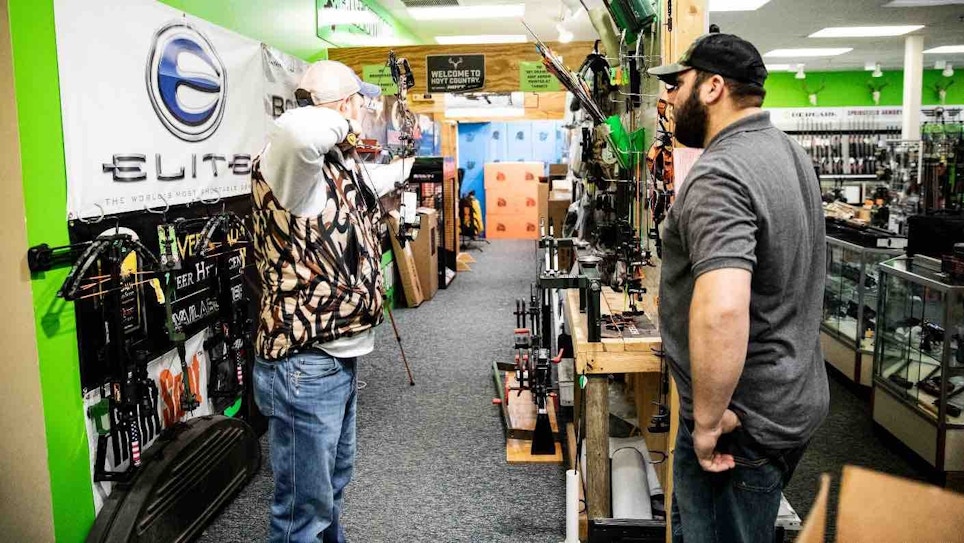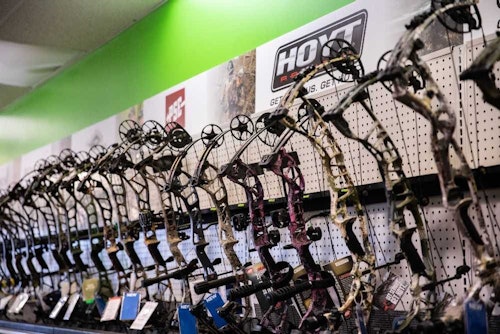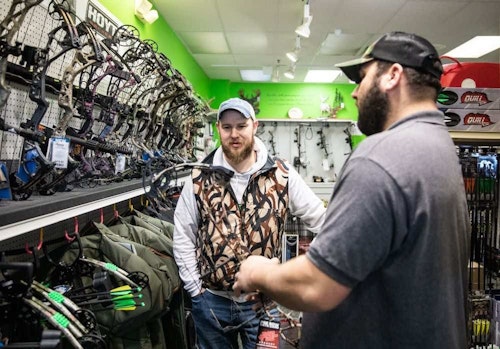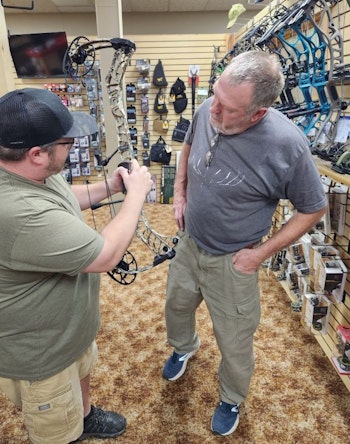
Some customers will test a new model side by side with a year-old model and decide that there isn't enough difference and elect to save some money. (Photo by Darron McDougal)
The archery industry’s most exciting time of the year is in full swing. Most bow manufacturers have released their new flagship bow models or soon will at the ATA Show. New bows always spark curiosity and excitement among dealers and consumers alike. And with most hunting seasons in the books, who couldn’t use some excitement to combat the winter doldrums?
Once again, bow manufacturers have rolled out some sweet new rigs — if you aren’t quite up to speed on the new-for-2024 bows, you’ll get a comprehensive rundown in the next issue. But for now, it’s time to consider your existing inventory and make plans (if you haven’t already done so) to clear the way so that your bow rack is ready for shipments of 2024 bows as they begin arriving.
It’s not ideal to have a bunch of 2023 models on your bow rack, but for some of you, it is a reality. Others of you are looking to improve your game. In this article, three well-experienced dealers will detail how to move old inventory, as well as how to purchase new models wisely. Follow along.

Brand Loyalty and Early Planning
Working with key manufacturers and forming solid relationships with them will help you as you plan to liquidate year-old bows and anticipate when the new ones will begin arriving.
“I’ve been in the business long enough to know a relative 2-week window for each manufacturer’s launch date,” said Chris Scott of Lancaster Archery Supply in Lancaster, Pennsylvania. “Still, we always communicate with our sales reps. They know when the new bows will be launched. July is a great time to start thinking about all of this.
“There are some unknowns. We can’t predict what the new bows will be. We also don’t know ship times. We don’t want to totally run out of bows before the new models arrive. When you know a brand inside and out, though, it’s much easier to make predictions and be in a good place when the new models arrive. In fall 2022, I was 100 percent sold out of 2022 models as the 2023 models were arriving, which is the best-case scenario. It doesn’t always work out that well.
“Another point for consideration is that manufacturer marketing continues to drive sales on last year’s bows even once the new models are out. If you watch outdoor TV or flip through hunting magazines, you’ll see ads still promoting the previous year’s flagship bow. This is quite confusing to consumers, but it certainly helps to get people in to buy those year-old models.”

Justin Steinke of Butch’s Archery in Clintonville, Wisconsin, said he doesn’t get too bent out of shape if a bow from a top-selling manufacturer carries over to the next year. “If I have a year-old Mathews on the shelf, I’m not worried about it,” he said. “I know that someone will buy it. In fact, I typically don’t have to discount it.”
Steinke mentioned that isn’t the case with the other brands he sells at Butch’s Archery. “I definitely have to get more aggressive and sometimes creative to get those other brands out the door before the new models start arriving.”
Watch for Off-MAP Periods
Most manufacturers implement MAP pricing to level the dealer playing field. MAP pricing eventually gets removed so that dealers can discount year-old models and move them out.
“As soon as a bow manufacturer informs us that a bow model is no longer under MAP-pricing policies,” Scott said, “I use that as a tool to move some inventory so I have more open-to-buy dollars for the new models. We generally start off our sale on off-MAP bow models with some type of in-store promotion, and we also do some social media promoting. I base the discounts on margins that I need to maintain, but I also take into account that I need to move those bows.”
Farron Moss of Hoffman Archery in Warrenton, Virginia, said that by the time the new models ship, he will no longer have any year-old bows from his top-selling manufacturers in stock. However, he could think of a brand or two that doesn’t sell as fast. If a bow is on his shelf for 2 years, he cuts the chains and discounts it by up to 50 percent. “It’s not pleasant, and I don’t want to take the loss. But, a bow that’s more than a year old does me no good sitting on the shelf. If it doesn’t sell for half off, I’d rather donate it.”
Steinke said that once the MAP period expires on a particular model, he has the liberty to do what makes the most sense for the business with pricing while managing his leftover bow inventory.
“I always try to cover the cost of each bow for the 2 months that follow the off-MAP period,” Steinke continued. “After that, sometimes I have to go below cost just to move it. Sometimes there are opportunities to sell a bow at cost to a fundraising banquet. I help the cause while covering my cost. Sometimes the banquet will promote the shop, too, so there’s a little advertising involved. It’s better than taking a big loss.”

Other Alternatives
Steinke said he hasn’t run into any instances in which a manufacturer will straight-up buy back unsold bows, but he did mention a similar opportunity that one manufacturer offers.
“Bear Archery has a program that allows the dealer to swap products within its family of brands,” he said. “Let’s say I have some Bear bow models that aren’t selling. I can trade those in for another model that people want. Or, I can turn $2,000 of bows, as another example, into $2,000 worth of Trophy Ridge sights and arrow rests. I’ve certainly utilized that program, and it’s nice because accessories don’t become outdated or obsolete as quickly as a specific bow model. I believe the swap has to be made by the end of July.”
Scott is also aware of Bear’s swapping program, although he hasn’t used it. He has, however, negotiated terms with other manufacturers.
“I keep in close contact with my sales reps,” he said. “I’ve worked out guaranteed-sales programs in the past. If a manufacturer is pushing a specific model that I feel is risky for me, I’ll ask them if they’re willing to do a guaranteed-sale program. There are usually stipulations. For example, unsold bows can’t have D-loops installed on them or have been shot. Guaranteed sales help mitigate the risk for me, the dealer, but I also haven’t had to send back very many bows.”
Ordering New Bows: Go Conservative or Heavy?
There are different schools of thought regarding the new-bow ordering picture. Some dealers, especially smaller ones, have fewer dollars available to buy right away. In contrast, large dealers that sell high volumes of bows almost have no choice but to go all in right away.
“We’re fortunate to have a huge following and high customer demand,” Scott said. “I go in heavy on new-bow orders right out of the gate. By going in heavy, when that gate opens, I have an entire year to sell those bows. If you have the open-to-buy dollars to do it right away, it’s safer to go heavy on the front end rather than on the back end.”
Moss said he tries to feel out the economy as he makes ordering plans. “I know that we can go heavy on the brands that have historically sold well. We get them ASAP so that we have new flagship models from the popular brands. As for the outliers — manufacturers that aren’t such big sellers — we’re fairly conservative. It’s necessary to have a mix of high-end and affordable bows, but ordering too heavy off the bat on less-popular brands/models can get you in trouble. The other thing is some manufacturers are building bows that simply aren’t worthy to be sold in a pro shop, and it’s easy to be stuck with those a year later.
“We’ve made the mistake of bringing in outlier bow brands just to see how they would go over. With some of the ‘off-brand’ bows, you might have only one in a couple of hundred customers who insists on shooting that brand. Everyone else goes with more popular name brands. Often, the manufacturer will require you to bring in a minimum of five bows, let’s say. So, I’d suggest being careful with which brands you buy. You can pretty well cover the low, middle and high price points within the well-known manufacturers. If you bring in five bows from an off-brand manufacturer, you might have three or four on your rack in 2 years due to a lack of demand.”
Other than with Mathews, Steinke always leans toward the minimums when ordering from the other brands that Butch’s Archery stocks.
“I don’t necessarily reach better pricing tiers because I don’t do enough numbers with those brands,” he said. “My goal is to keep the bow rack nice and full with what I believe will sell. You can make some predictions, but you never know exactly how many bows you’ll sell in a given year. For example, we sold many more compound bows in 2023 than we did in the previous few years, including the years when the stimulus payments were sent out. I’m not quite sure why that was the case.
“The biggest mistake that always seems to get me is ordering too heavy on the high-end carbon bows. Even when discounted after the MAP period expires, a high-end carbon bow is still $1,300 to $1,500. That is still more expensive than a premium machined-aluminum bow. If I order two or three too many, then I have too much money tied up into bows that don’t sell as fast as the others.”
Are You Ready for Flagship Season?
As you can see, there isn’t a magic, one-size-fits-all plan for juggling flagship season, although there are some commonalities between the three dealers who generously supplied input for this article. Perhaps you can relate with one dealer more than another. Regardless, the goal is to improve at this every year so you can be prepared for flagship season. I believe these three dealers have brought enough light to the subject to help you do just that.
Sidebar: Creative Ways to Push Year-Old Bows
Justin Steinke of Butch’s Archery in Clintonville, Wisconsin
“Once bowhunting season opens,” Steinke said, “the sales approach for year-old models becomes pretty aggressive. If a customer has a color preference, but we have the bow they want in another finish on hand, I’ll say, ‘Hey, I’ll throw in a free bowsight or give you $100 off if you buy this one today.’ I’m trying to remove that inventory before it gets too late in the year. That entire scenario is brand-specific. There are bows that are slower-selling than others, and I need to be attentive toward opportunities to move those out.”
Chris Scott of Lancaster Archery Supply in Lancaster, Pennsylvania
“My staff and I try to push the year-old models when it makes sense,” Scott said. “There are some good merits for the consumer. In some cases, they’re getting a couple hundred bucks off a new bow, and that enables them to purchase a high-end model rather than a budget bow. We basically bridge the financial gap between a high-end and mid-priced bow with a very good solution. We move a year-old bow out the door, and they leave the store ecstatic because they got a high-performance bow rather than just a ‘decent’ bow. They’re happy, and they’ll be back in the future.”
Farron Moss of Hoffman Archery in Warrenton, Virginia
“Sometimes a customer comes in looking to order a specific bow and color,” Moss said. “If we have that bow model in a different color, we’ll offer them a 5% discount on that in-stock bow. It isn’t exactly what they came in for, but it’s the same model. They get to save a few bucks and take the bow home right away rather than wait for a special order to arrive. And, we get to move a year-old model off the rack.”






